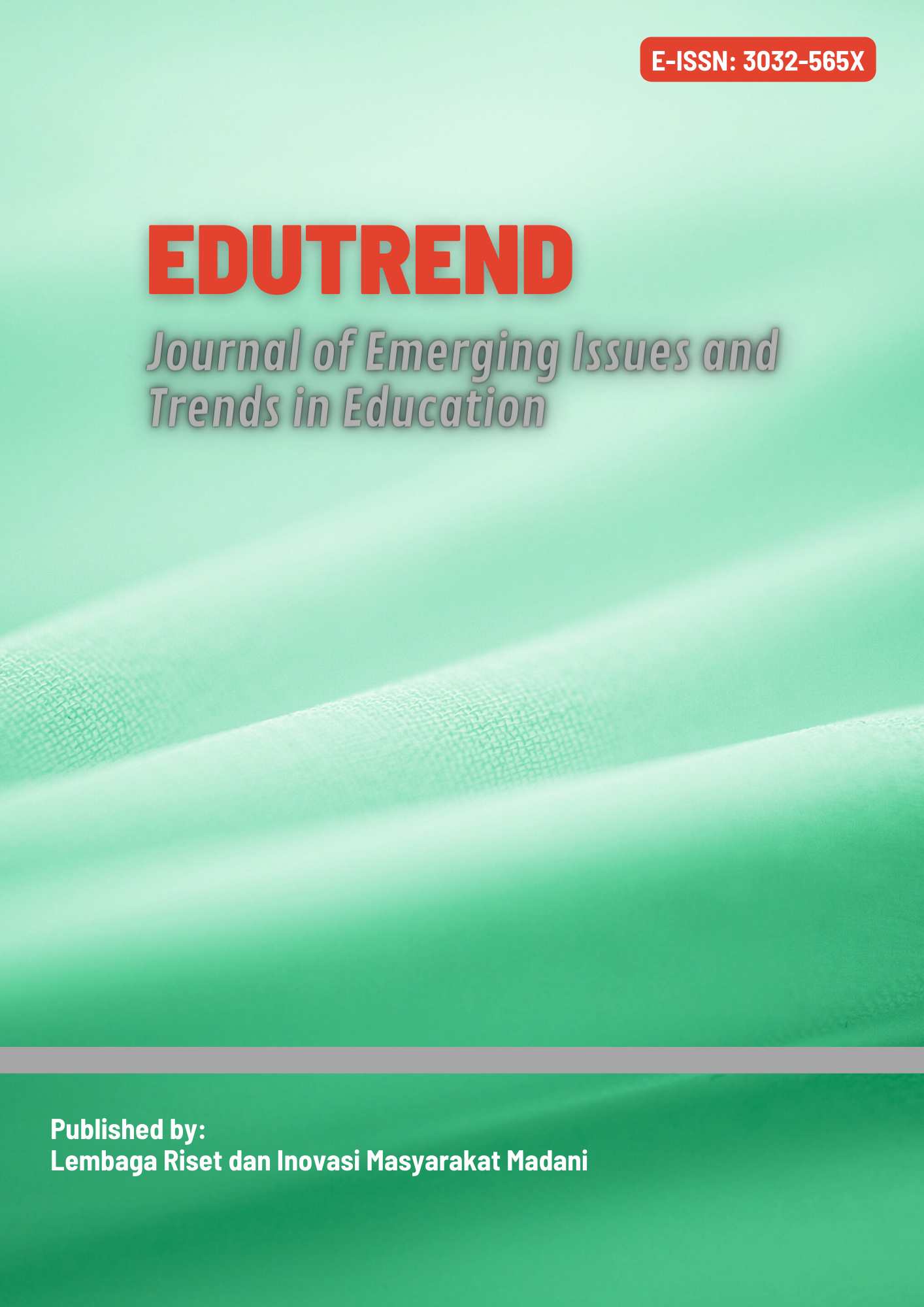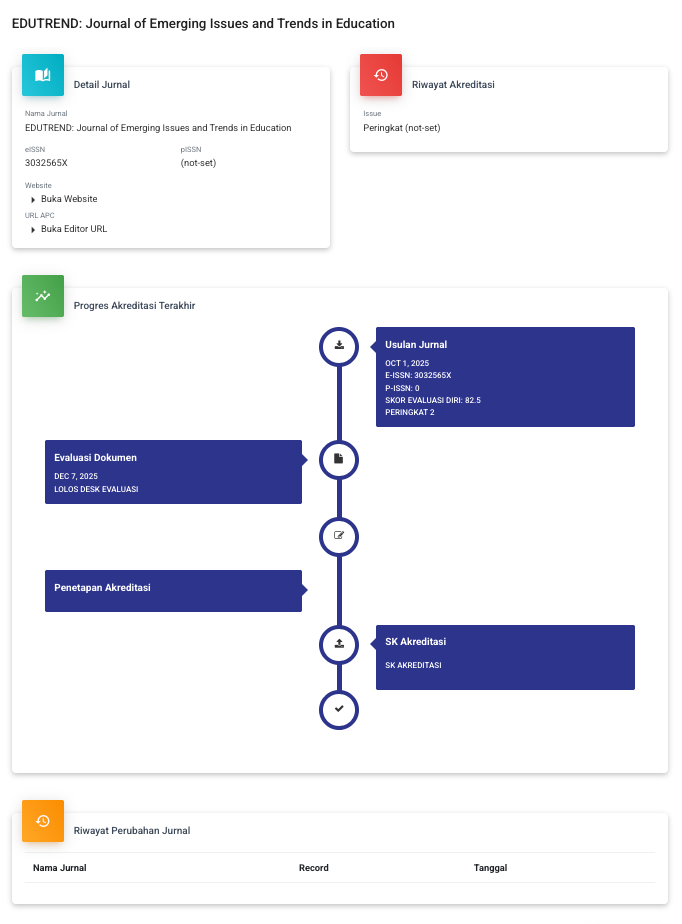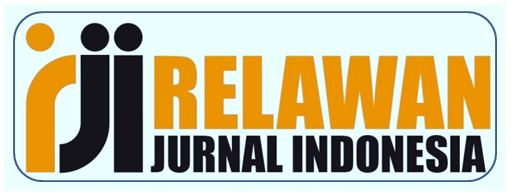Technology Adoption and Pedagogical Shifts in Central Sulawesi's Secondary Education
DOI:
https://doi.org/10.59110/edutrend.604Keywords:
Central Sulawesi, Educational Technology, Regional Disparities, Secondary Education, Technology AdoptionAbstract
This research looks at the adoption patterns of educational technology in Palu City, Sigi Regency, and Donggala Regency, three areas in Central Sulawesi. Although there are notable differences between urban and rural settings, the quick incorporation of technology in education is essential to enhancing learning results. This study's main goal is to examine how secondary schools in these areas have used instructional technology from Education 1.0 to Education 5.0. Using a quantitative descriptive approach, the study gathers survey data from senior high school students attending Islamic, public, and private institutions as well as vocational schools. With 160 student responses, the analysis is arranged according to five major regions: Palu City, Sigi Regency, and Donggala Regency, according to the results, Sigi Regency exhibits a moderate adoption of Education 2.0 and early Education 3.0 tools, whereas Palu City exhibits the highest degree of technological integration, especially in Education 3.0 and 4.0. The biggest obstacles, however, are found in Donggala Regency, where most schools continue to use Education 1.0 and 2.0 approaches. The report identifies the primary obstacles, such as regional differences in digital resources, poor infrastructure, and insufficient teacher preparation. Considering the findings, it is evident that in order to close the digital gap and guarantee the successful integration of educational technology in all areas, a more equal allocation of resources and focused legislative initiatives are necessary.
References
Ahmar, D. S., & Azzajjad, M. F. (2023). Literature review: Bulletin media in learning as a literacy resource in strengthening the national literacy movement program. Athena: Journal of Social, Culture and Society, 2(1), 280–288. https://doi.org/10.58905/athena.v2i1.207
Ahmar, D. S., Magfirah, M., Poba, D., & Azzajjad, M. F. (2023). Gamification learning integrated with local wisdom based on character education: Is there an effect on problem solving ability? Jurnal Penelitian Pendidikan IPA, 9(9), 7614–7620. https://doi.org/10.29303/jppipa.v9i9.4968
Alannasir, W. (2020). Characteristic-based development students’ aspect. International Journal of Asian Education, 1(1), 29–36. https://doi.org/10.46966/ijae.v1i1.18
Biletska, I. O., Paladieva, A. F., Avchinnikova, H. D., & Kazak, Y. Y. (2021). Use of modern technologies by foreign language teachers: Developing digital skills. Linguistics and Culture Review, 5(S2). https://doi.org/10.21744/lingcure.v5ns2.1327
Cesário, V., & Nisi, V. (2023). Lessons learned on engaging teenage visitors in museums with story-based and game-based strategies. Journal on Computing and Cultural Heritage, 16(2). https://doi.org/10.1145/3575867
Chakraborty, S., Gonzalez-Triana, Y., Mendoza, J., & Galatro, D. (2023). Insights on mapping Industry 4.0 and Education 4.0. Frontiers in Education, 8. https://doi.org/10.3389/feduc.2023.1150190
Dewi, C. A., Pahriah, P., & Purmadi, A. (2021). The urgency of digital literacy for Generation Z students in chemistry learning. International Journal of Emerging Technologies in Learning, 16(11). https://doi.org/10.3991/ijet.v16i11.19871
Mansyur, F. A., Arsad, A., Himah, I. A., Zaka, I., Zilani, Z., & Syarifuddin, I. (2022). Languange Learning Adapatation Model in The Era of Society 5.0. ELS Journal on Interdisciplinary Studies in Humanities, 5(4), 686-693. https://doi.org/10.34050/elsjish.v5i4.21499
Gros, B., & García-Peñalvo, F. J. (2023). Future trends in the design strategies and technological affordances of e-learning. In Learning, design, and technology (pp. 345–367). Springer International Publishing. https://doi.org/10.1007/978-3-319-17461-7_67
Kabilan, M. K., Annamalai, N., & Chuah, K. M. (2023). Practices, purposes and challenges in integrating gamification using technology: A mixed-methods study on university academics. Education and Information Technologies, 28(11). https://doi.org/10.1007/s10639-023-11723-7
Kumar, S., Goel, U., Joshi, P., & Johri, A. (2024). Factors affecting Information & Communication Technology (ICT) adoption among MSMEs. Journal of Open Innovation: Technology, Market, and Complexity, 10(1). https://doi.org/10.1016/j.joitmc.2023.100205
Lang, V., Špernjak, A., & Šorgo, A. (2024). The relationship between the daily use of digital technologies and the reading and information literacy skills of 15-year-old students. European Journal of Educational Research, 13(1). https://doi.org/10.12973/eu-jer.13.1.43
Lester, D., Skulmoski, G. J., Fisher, D. P., Mehrotra, V., Lim, I., Lang, A., & Keogh, J. W. L. (2023). Drivers and barriers to the utilisation of gamification and game-based learning in universities: A systematic review of educators’ perspectives. British Journal of Educational Technology. https://doi.org/10.1111/bjet.13311
Li, G., Sun, Z., & Jee, Y. (2019). The more technology the better? A comparison of teacher-student interaction in high and low technology use elementary EFL classrooms in China. System, 84, 24–40. https://doi.org/10.1016/j.system.2019.05.003
Li, J., Luo, H., Zhao, L., Zhu, M., Ma, L., & Liao, X. (2022). Promoting STEAM education in primary school through cooperative teaching: A design-based research study. Sustainability, 14(16). https://doi.org/10.3390/su141610333
Lindsay, J., Crouch, V., & Cutcliffe, K. (2022). Disrupting the traditional academic development model: Technology demonstrators. ASCILITE Publications. https://doi.org/10.14742/apubs.2022.167
Meng, N., Dong, Y., Roehrs, D., & Luan, L. (2023). Tackle implementation challenges in project-based learning: A survey study of PBL e-learning platforms. Educational Technology Research and Development, 71(3), 1179–1207. https://doi.org/10.1007/s11423-023-10202-7
Merelo, J. J., Castillo, P. A., Mora, A. M., Barranco, F., Abbas, N., Guillén, A., & Tsivitanidou, O. (2024). Chatbots and messaging platforms in the classroom: An analysis from the teacher’s perspective. Education and Information Technologies, 29(2). https://doi.org/10.1007/s10639-023-11703-x
Muktiarni, M., Widiaty, I., Abdullah, A. G., Ana, A., & Yulia, C. (2019). Digitalisation trend in education during industry 4.0. Journal of Physics: Conference Series, 1402. https://doi.org/10.1088/1742-6596/1402/7/077070
Nuryadi, M. H., & Widiatmaka, P. (2023). Strengthening civic literacy among students through digital literacy in society 5.0. Journal of Education and Learning, 17(2). https://doi.org/10.11591/edulearn.v17i2.20746
Quach, S., Thaichon, P., Martin, K. D., Weaven, S., & Palmatier, R. W. (2022). Digital technologies: Tensions in privacy and data. Journal of the Academy of Marketing Science, 50(6). https://doi.org/10.1007/s11747-022-00845-y
Sadi, H., Septiwiharti, D., & Mutawakkil, M. (2023). Kaili traditional classification: The customs influence on Kaili Kingdom’s authority in Palu Valley. Research, Society and Development, 12(2). https://doi.org/10.33448/rsd-v12i2.40223
Satria Ahmar, D., & Fath, M. (2024). Trend map: A bibliometric exploration of the utilization of chemical education bulletins in the digital age. Chemistry Education Journal Arfak Chem, 7. http://jurnal.unipa.ac.id/index.php/accej
Satria, D., 1, A., & Azzajjad, M. F. (2025). Golden age and inclusive education pendekatan neuroeducation dalam meningkatkan perkembangan kognitif dan sosial anak usia golden age. 2(1).
Siradjuddin, Z. (2021). Evolution of Tokaili settlement process in Central Sulawesi, Indonesia. Advances in Social Sciences Research Journal, 8(4). https://doi.org/10.14738/assrj.84.10097
Suherman, L. O. A., Hamka, N., & Akfan, S. S. (2024). Perceiving Duolingo beyond the classroom: insights from non-English major students in higher education. Diglosia: Jurnal Kajian Bahasa, Sastra, Dan Pengajarannya, 7(4), 715-724. https://doi.org/10.30872/diglosia.v7i4.1069
Susilawati, W., & Sugilar, H. (2021). Technological pedagogical content knowledge analysis. Numerical: Jurnal Matematika dan Pendidikan Matematika. https://doi.org/10.25217/numerical.v5i1.1116
Tiken20, N., Yeni Erita, Rati Syafiana Putri, & Salmiyanti. (2023). Application of electronic learning and educators’ challenges in the 21st century. Journal of Digital Learning and Distance Education, 1(11). https://doi.org/10.56778/jdlde.v1i11.63
Ulya, C., Putri, U. R., Setyawan, B. W., Samsiyah, N., Septiana, H., & Joyotu, T. S. (2023). A bibliometric analysis on “edu-technopreneurship” topic and chance on its development in language, literature, and literacy fields. Bahastra, 43(2). https://doi.org/10.26555/bs.v43i2.502
van Dulmen, T. H. H., Visser, T. C., Pepin, B., & McKenney, S. (2023). Teacher and student engagement when using learning materials based on the context of cutting-edge chemistry research. Research in Science and Technological Education, 41(4), 1617–1638. https://doi.org/10.1080/02635143.2022.2070147
Wang, D., Zhou, T., & Wang, M. (2021). Information and communication technology (ICT), digital divide and urbanization: Evidence from Chinese cities. Technology in Society, 64. https://doi.org/10.1016/j.techsoc.2020.101516
Zhang, Z., & Ibarra, B. (2024). Mapping the problem statement and study purposes to the quantitative analysis: Insights from mixed methods perspectives. Journal of Education and Development, 8(1). https://doi.org/10.20849/jed.v8i1.1408
Downloads
Published
How to Cite
Issue
Section
License
Copyright (c) 2025 Dewi Satria Ahmar, Muhammad Fath Azzajjad

This work is licensed under a Creative Commons Attribution-ShareAlike 4.0 International License.















 the Creative Commons Attribution-ShareAlike 4.0 International License |
the Creative Commons Attribution-ShareAlike 4.0 International License | 